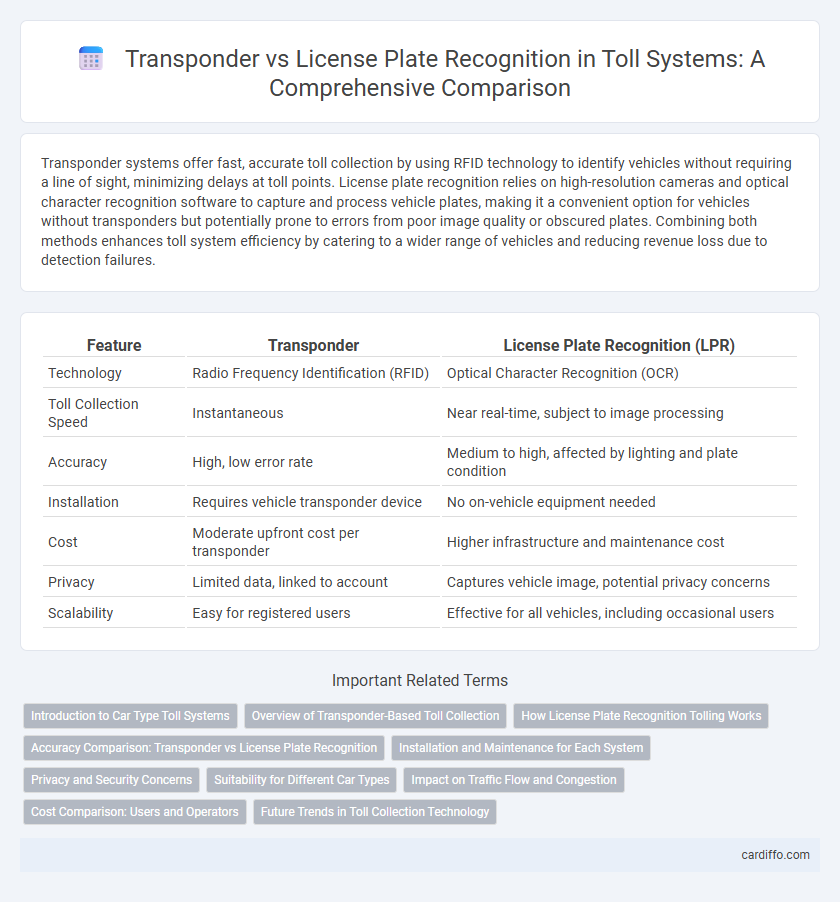Transponder systems offer fast, accurate toll collection by using RFID technology to identify vehicles without requiring a line of sight, minimizing delays at toll points. License plate recognition relies on high-resolution cameras and optical character recognition software to capture and process vehicle plates, making it a convenient option for vehicles without transponders but potentially prone to errors from poor image quality or obscured plates. Combining both methods enhances toll system efficiency by catering to a wider range of vehicles and reducing revenue loss due to detection failures.
Table of Comparison
| Feature | Transponder | License Plate Recognition (LPR) |
|---|---|---|
| Technology | Radio Frequency Identification (RFID) | Optical Character Recognition (OCR) |
| Toll Collection Speed | Instantaneous | Near real-time, subject to image processing |
| Accuracy | High, low error rate | Medium to high, affected by lighting and plate condition |
| Installation | Requires vehicle transponder device | No on-vehicle equipment needed |
| Cost | Moderate upfront cost per transponder | Higher infrastructure and maintenance cost |
| Privacy | Limited data, linked to account | Captures vehicle image, potential privacy concerns |
| Scalability | Easy for registered users | Effective for all vehicles, including occasional users |
Introduction to Car Type Toll Systems
Car type toll systems utilize advanced identification methods, primarily transponder technology and license plate recognition, to automate toll collection based on vehicle classification. Transponder systems rely on RFID devices installed in vehicles, enabling real-time communication with toll gantries for seamless transactions. License plate recognition leverages high-resolution cameras and optical character recognition (OCR) software to identify and charge vehicles without physical devices, offering a flexible alternative for toll operators.
Overview of Transponder-Based Toll Collection
Transponder-based toll collection uses radio-frequency identification (RFID) technology to enable fast, contactless payment at toll plazas. Vehicles equipped with transponders transmit a unique identification signal to roadside readers, automatically deducting toll fees from pre-paid accounts or linked payment methods. This system reduces congestion and enhances traffic flow compared to license plate recognition, which relies on image processing and manual billing.
How License Plate Recognition Tolling Works
License Plate Recognition (LPR) tolling works by using high-resolution cameras to capture images of vehicles' license plates as they pass through toll points. Advanced optical character recognition (OCR) software processes these images to accurately read the alphanumeric characters, linking the vehicle to a registered account or billing address. This system eliminates the need for physical transponders, enabling seamless toll collection via automatic image processing and database cross-referencing.
Accuracy Comparison: Transponder vs License Plate Recognition
Transponder systems offer superior accuracy in toll collection by utilizing RFID technology to detect vehicles instantly, reducing errors caused by environmental factors. License plate recognition (LPR) relies on optical character recognition, which can be hindered by poor lighting, dirty plates, or obstructions, leading to a higher rate of misreads. Consequently, transponders provide more reliable toll processing, lowering the risk of billing errors compared to LPR systems.
Installation and Maintenance for Each System
Transponder systems require individual device installation inside each vehicle, involving minimal roadside infrastructure but ongoing maintenance of transponder batteries and functionality. License plate recognition (LPR) relies on high-resolution cameras mounted on toll gantries or poles, necessitating precise alignment and periodic cleaning to ensure accurate image capture. While transponders demand active management per vehicle, LPR focuses maintenance efforts on camera calibration, lighting, and software updates for optimal plate reading performance.
Privacy and Security Concerns
Transponder-based toll systems enhance privacy by transmitting encrypted vehicle identification data, minimizing the risk of unauthorized tracking compared to license plate recognition, which captures and stores images that could be misused. License plate recognition systems raise significant security concerns due to potential data breaches and unauthorized access to sensitive personal information linked to vehicle registrations. Transponders offer stronger protection against identity theft and surveillance by limiting data collection to essential toll transactions and utilizing secure communication protocols.
Suitability for Different Car Types
Transponder systems are highly suitable for private vehicles and commercial fleets due to their fast, reliable electronic identification, minimizing toll delays. License plate recognition (LPR) offers greater flexibility for rental cars, motorcycles, and vehicles without transponders, using advanced camera technology for accurate image capture and processing. Both methods integrate seamlessly with toll infrastructure, but LPR's versatility makes it ideal for diverse vehicle types lacking pre-installed transponders.
Impact on Traffic Flow and Congestion
Transponder-based toll systems significantly improve traffic flow by enabling seamless, high-speed vehicle identification without stopping or slowing down, reducing congestion at toll plazas. License plate recognition systems can experience delays due to image processing and error rates, causing occasional bottlenecks especially during peak hours. Integrating advanced transponders minimizes traffic congestion and enhances overall roadway efficiency compared to plate-based systems.
Cost Comparison: Users and Operators
Transponder systems require an upfront investment in devices, which can be costly for users, but they offer lower transaction fees and faster processing times, benefiting operators by reducing operational expenses. License plate recognition (LPR) eliminates user device costs, appealing to infrequent users, yet higher infrastructure and maintenance expenses for operators make it less cost-effective over time. Operators often choose transponders for consistent revenue streams, while LPR suits environments prioritizing user convenience and minimal barriers to entry.
Future Trends in Toll Collection Technology
Future trends in toll collection technology emphasize seamless integration of transponder systems and advanced license plate recognition (LPR) for enhanced accuracy and efficiency. Innovations in AI-driven LPR improve vehicle identification in varied lighting and weather conditions, reducing violations and revenue loss. Hybrid models combining transponders with real-time LPR analytics are expected to dominate, enabling dynamic pricing and improved traffic flow management.
Transponder vs license plate recognition Infographic

 cardiffo.com
cardiffo.com